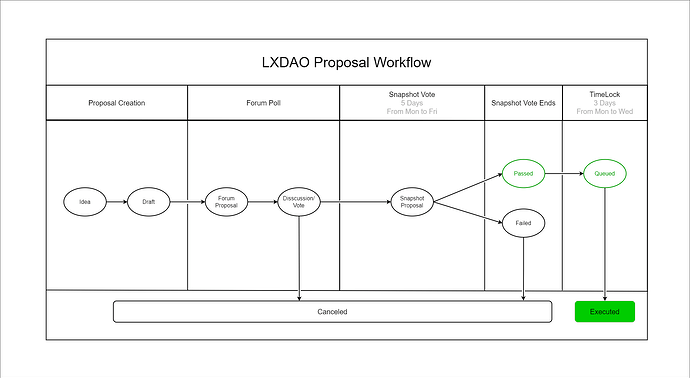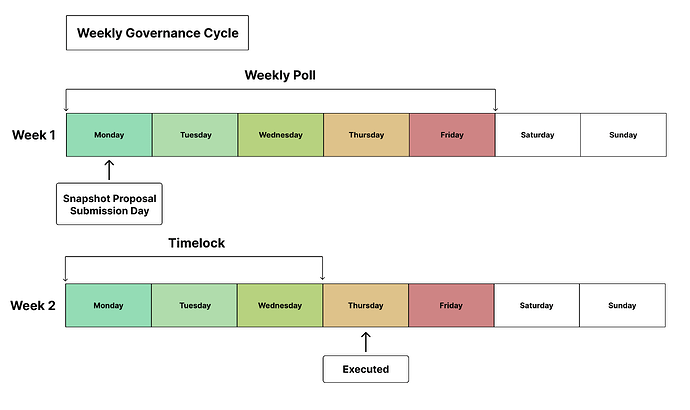1. What is LIP?
Motivation
A formal decision-making process is required for LXDAO to evolve into a fully decentralized and self-sustainable organization. Everyone should be able to propose changes and improvements in a protocol that does not require a license.
The LIP framework empowers each off-chain and on-chain governance participant by providing a standardized way to interact with the broader DAO and define its future shape.
TL;DR
The LIP stands for LXDAO Improvement Proposal. LIP is a design document that provides information to the LXDAO community or describes new functionality for LXDAO or its processes or environment. the LIP should provide a concise technical specification of the functionality and the rationale for the functionality. LIP author is responsible for building consensus within the community and documenting dissenting opinions.
2. Types of LIPs
There are three types of LIPs:
Governance proposal
Governance refers to the system of institutions that allow decisions to be made. A governance mechanism is a set of decision rules and action standards that stakeholders in the blockchain ecosystem agree on for decision-making. The purpose is to allow LXDAO to evolve iteratively over time. The scope of governance proposals includes, but is not limited to, governance mechanisms, organizational frameworks, tokenomics, incentive rules, etc. The purpose of governance proposals is to serve the community better. And governance proposal should be assigned a number and become a LIP.
Project Proposal
A project proposal is a project-focused proposal that includes a brief description of the new project and collaboration, the background, the duration, the scope of the work, the budget, etc.
Other Proposals
If there are proposals that are not related to governance and project categories, they are all classified as other proposals
3. Proposal Workflow
The following is a standardized process for all proposals:
Idea
Everything starts from a simple idea.
Draft
Write down your idea and make a draft.
Forum Proposal
You can create a Forum Proposal on LXDAO Forum. And create an informal poll by using the feature from Forum.
The informal poll provided the community with options to vote on. They cannot influence protocol changes or immediately trigger the process; they are typically used to gather the community’s opinion on issues affecting the LXDAO ecosystem.
Snapshot Proposal
Snapshot voting is only available to LXDAO Buidler Card holders; one builder card equals one vote. Only LXDAO Buidler Card holders can create snapshot proposals.
A Snapshot Proposal is normally created every Monday, and the voting period is five days from Monday to Friday. We also provide an urgent proposal workflow below.
For more details about joining LXDAO and getting LXDAO Buidler Card, please refer to: Join us | LXDAO.
Timelock
A timelock can lock certain smart contract features for a while. It improves the security of smart contracts. After the proposal is approved, there will be a three-day (working day) time lock period, normally starting from Monday to Wednesday, and executed on Thursday.
QA
Why do we need a Forum Poll?
Begin by opening a forum poll to publicize the proposal before initiating a Snapshot Proposal and seek community consensus through lobbying or advocacy sessions. This can save time and increase the chances of passing the proposal.
Typically, we would prepare numerous files (product documents, prototypes, etc.) for a Snapshot Proposal, but it’s smarter to first post ideas on the Forum to gauge their appeal and community consensus before investing significant time and effort into it.
Why do we need a time lock?
A timelock is a piece of code that locks a certain functionality of a smart contract until a specific amount of time has passed. Most often, this is the ability to transfer a token out of the contract. This makes it similar to a vesting schedule — funds won’t be accessible until a certain date, time, or block height.
It provides a cool-down period for the community to check if someone is abusing or attacking the community. We can create an urgent proposal to reset the proposal during the timelock period and stop the tokens transfer.
4. Urgent Proposal
Urgent proposals have a short voting period of one to three days, and apply to the following scenarios:
- Some proposals violate LXDAO’s core values and consensus
- Crisis occurs, we need to take action quickly
- The community and most buidlers disagree with the proposal but, due to some reasons, did not realize during the voting period
Urgent proposals are implemented immediately after adoption.
5. Proposal Template
Title
For the Governance proposals, the Title should start with “LIP” + number. For the Project proposals, the Title should start with “Project:”. For other proposals, no restrictions yet.
Body
A good proposal structure is important for the Community to understand and vote for. Feel free to contact LXDAO Governance WG to review and improve if you are unfamiliar with the proposal creation for better quality.
Here is the recommended structure of a proposal, you could also find examples from existing proposals on Snapshot:
Title: [CONCISE TITLE - KEEP CLEAN]
Authors: [NAME]
Date Created: [ADD CREATED DATE]
## TL;DR
Sum up this proposal in a few points or sentences.
## Proposal Description
### Background
Why are you making this proposal?
What issue or opportunity is this proposal addressing?
What are the driving factors behind why you think this is a good idea?
Why do we create or collaborate on this project?
### Details
Detailed information about the proposal. What is the solution? What are we going to do? What are the MVP features of the project? What is the prototype link of the project? How much work to do?
Do your best to be realistic in expectations and tie your funding ask to what is achievable with that amount of money.
### Team settings
How many people do you need? What are their skills?
### Duration and Milestones
How long do you think it needs, and what are the milestones?
## Budgets and distribution
Include details about funding requirements. You must include a detailed breakdown that explains how the funds will be allocated. Funding will not be approved for proposals without a funding breakdown. This is where the squad can request rewards for their expected contributions to the project, including any work done to scope the project and create the proposal.
## Revenue distribution
Potential revenue from the project, citing the revenue generated by the project and the revenue distribution plan.
## Key results
How will the project’s success be measured?
6. Voting Rules
Proposal Adoption Rules
The adoption rules for proposals use dynamic thresholds:
The minimum number of absolute positive votes: ≥ 20% of all buidlers.
Explanation:
- Absolute positive votes = positive votes - negative votes. For example, 30 For, 20 Against, and Abstain, the Absolute positive votes = 10.
- Negative votes include Against and Abstain.
Examples (assuming we have 50 buidlers):
- For a proposal with 10 positive votes and 0 negative votes. Result: Passed, because 10 - 0 = 10 ≥ 20% of 50.
- For a proposal with 10 positive votes and 1 negative vote. Result: Failed, because 10 - 1 = 9 < 20% of 50.
- For a proposal with 29 positive votes and 21 negative votes. Result: Failed.
In summary, we’ve lowered the threshold (20% of builders) for passing a proposal. As a result, we’ve also added weights to oppose proposals. If you disagree with a proposal, your negative vote is highly significant.
This will encourage buidlers to participate in governance and vote against it. Previously, if there were 10 positive and no negative votes, buidlers might be intended to vote for positive ones, as their negative votes do not affect the proposal results.
Also, it increases the vote efficiency as there is no need for every buidler to vote. In return, in LXDAO tokenomics design, should airdrop more for the buidlers who participate in governance actively.
Proposal Failure Rules
Proposals are often rejected due to low voter participation, lack of detail, or lack of community consensus through extensive discussion.
You can initiate a Snapshot poll by initiating a discussion or presentation, making changes and additions to the proposal, and submitting a rejected proposal for the next governance cycle. A proposal can be submitted up to three times.
7. Weekly Governance Cycle
The weekly governance cycle lasts 5 days, starting from Monday to Friday. And timelock starts from next Week Monday to Wednesday, executed on Thursday. This provides a predictable framework for LXDAO’s decision governance:
Monday: Snapshot Proposal Submission Day
Monday to Friday: Voting Day
QA
What if I missed the proposal submission on Monday?
Be prepared and submit on next Monday. We have to give around 5 days for the community to review the proposal thoroughly and make decisions.

